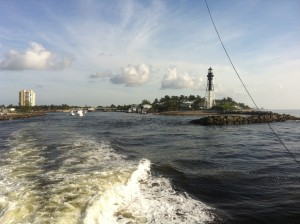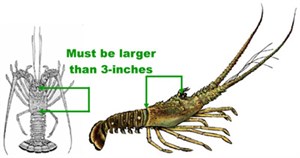With Florida Lobster Mini Season just over one week away, it’s time to get out on the water and scout out these tasty Florida creatures. Yesterday, I ventured out on my first prospective dive of the season departing the Hillsboro Inlet on the east coast of Florida in Pompano Beach. The wind was light, visibility was great, but I experienced an unusual and strong south current that brought some confusion to the dive. There have been many scattered reports for the season, and I decided to start off with a deep dive on the third reef in 100′ of water near the Commercial Pier in Ft. Lauderdale. Throughout the dive, I came across about a half dozen Hogfish in the 12-14 inch range. I was fortunate to land my spear shaft in one of these hogfish, and the fish got off my spear and swam into a hole in 93 feet of water. As I swam up to the hole, not only did I see the injured fish, but I found lobster! It is common when diving to find grouper and hogfish seeking shelter in a hole with lobster. Throughout the dive, I came across 4 lobster which were small and well hidden. Of these four, two of the bugs would have met the legal size requirements if season were open.

It is important to remember that the Carapace of the lobster needs to be at least 3 inches and needs to be measured in the water. My favorite technique to catching the lobster is to use a “tickle stick”, a 2 foot metal prong, and a small net. Throughout the state of Florida with the exception of Monroe county, divers can harvest 12 lobster a day during the 2 day mini season which is double the regular season limit of 6 per person. However, Monroe county only allows 6 lobster per person to be harvested during the mini season. Remember to get your Florida Fishing License with a lobster stamp and get out on the water and enjoy the great Florida tradition of lobster mini season on July 30th and 31st.

-Kyle Good
